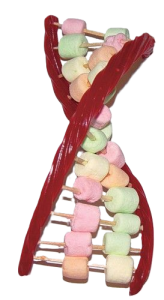
DNA, short for deoxyribonucleic acid, is a double helix molecule found in the nuclei of cells. It consists of two long strands made up of nucleotides, which contain a sugar-phosphate backbone and nitrogenous bases. Adenine (A) pairs with thymine (T), and cytosine (C) pairs with guanine (G), forming the complementary base pairs that stabilize the DNA structure. This elegant arrangement of nucleotides forms the basis of the genetic code, essential for the transmission and expression of genetic information in all living organisms
Students can get a more detailed model of DNA by completing this DNA Coloring Worksheet.
How Can You Model the DNA Molecule?
Materials Needed:
- Red licorice (representing the sugar-phosphate backbone)
- Different colored mini marshmallows (representing the nitrogenous bases)
- Toothpicks
Model Assembly:
- Distribute the licorice, different colored mini marshmallows, and toothpicks to each student or group.
- Assign a specific color to each nitrogenous base (e.g., red for adenine, green for thymine, blue for cytosine, yellow for guanine).
- Instruct the students to thread the large marshmallows onto the toothpicks, alternating with the colored mini marshmallows to represent the nitrogenous bases.
- Encourage the students to build two parallel strands of DNA by aligning the marshmallows and toothpicks in a double helix shape.
- Emphasize the complementary base pairing: adenine (red) pairs with thymine (green), and cytosine (blue) pairs with guanine (yellow).
- Ensure that the students create hydrogen bonds (represented by the toothpicks) between the complementary base pairs.
HS-LS3-1 Ask questions to clarify relationships about the role of DNA and chromosomes in coding the instructions for characteristic traits passed from parents to offspring.

